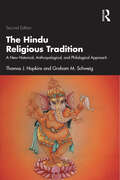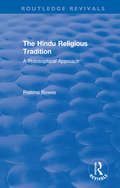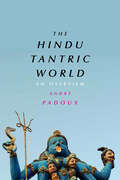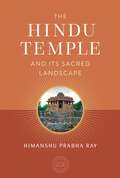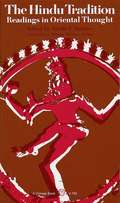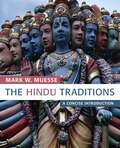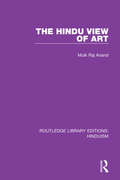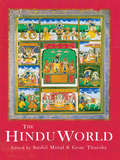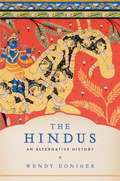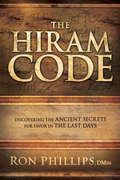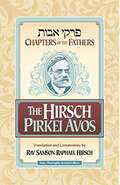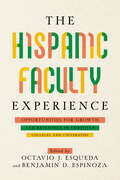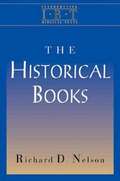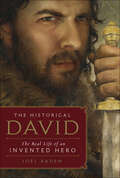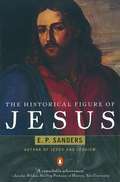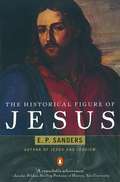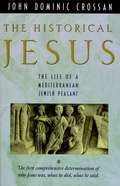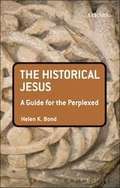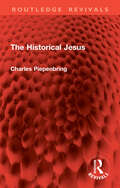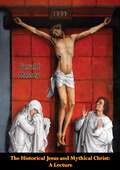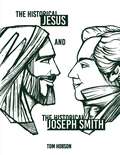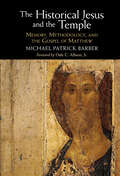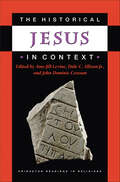- Table View
- List View
The Hindu Family and the Emergence of Modern India
by Eleanor NewbiginBetween 1955 and 1956 the Government of India passed four Hindu Law Acts to reform and codify Hindu family law. Scholars have understood these acts as a response to growing concern about women's rights but, in a powerful re-reading of their history, this book traces the origins of the Hindu law reform project to changes in the political-economy of late colonial rule. The Hindu Family and the Emergence of Modern India considers how questions regarding family structure, property rights and gender relations contributed to the development of representative politics, and how in solving these questions, India's secular and state power structures were consequently drawn into a complex and unique relationship with Hindu law. In this comprehensive and illuminating resource for scholars and students, Newbigin demonstrates the significance of gender and economy to the history of twentieth-century democratic government, as it emerged in India, and beyond.
The Hindu Religious Tradition: A New Historical, Anthropological, and Philological Approach
by Graham M. Schweig Thomas J. HopkinsThe Hindu Religious Tradition by Thomas J. Hopkins, originally published in 1971, provided a comprehensive survey of Hindu development from the Indus civilization to the present. This new edition incorporates up-to-date scholarship to provide a more complete history of India’s cultural and religious development, and is an invaluable resource for students in need of an introduction to the history and practice of Hinduism.In addition to textual analysis, this book offers a new approach to the study of Hinduism that reconstructs the history of India through an examination of scientific research on geography, archaeology, genetics, art history, linguistic and inscriptions, bringing to awareness the ways that patterns of cultural development, migration, kingship, and technology impacted the synthesis and integration of a wide range beliefs and practices into what we call Hinduism today. Extending beyond the borders of present-day India, The Hindu Religious Tradition shows how Hinduism was influenced by other civilizations in modern day Greece and Iran, and how it influenced them as well. This volume will provide new students of Indian religion with a detailed understanding of Hinduism’s rich history and scriptural canons, and it will provide scholars of Hinduism with a fresh perspective rooted in historical detail, offering both a more complete picture of how the Hindu religion is a network of beliefs and practices drawn from multiple civilizations and cultures over its vast history.
The Hindu Religious Tradition: A Philosophical Approach (Routledge Revivals)
by Pratima BowesOriginally published in 1977, The Hindu Religious Tradition provides a detailed exploration into the different doctrines regarding the nature of Religious Reality and the many paths of search for this Reality within the Hindu religion. The book discusses these differing doctrines from the point of view of their philosophical significance and their use in man’s search for the divine in consideration of the traditional teaching that the divine is already in man and can be realised in direct experience. It provides a comprehensive account of this tradition through considering all aspects that are integral to it, and highlights that the profundity of this tradition lies in that it cannot be limited to the requirements of any one form of conceiving the divine. The Hindu Religious Tradition will appeal to those with an interest in Hinduism, religious philosophy, and theology.
The Hindu Tantric World: An Overview
by André PadouxTantra occupies a unique position in Western understandings of Hindu spirituality. Its carnal dimension has made its name instantly recognizable, but this popular fascination with sex has obscured its philosophical depth and ritual practices, to say nothing of its overall importance to Hinduism. This book offers a clear, well-grounded overview of Tantra that offers substantial new insights for scholars and practitioners. André Padoux opens by detailing the history of Tantra, beginning with its origins, founding texts, and major beliefs. The second part of the book delves more deeply into key concepts relating to the tantric body, mysticism, sex, mantras, sacred geography, and iconography, while the final part considers the practice of Tantra today, both in India and in the West. The result is an authoritative account of Tantra’s history and present place in the world.
The Hindu Temple and Its Sacred Landscape (The Oxford Centre for Hindu Studies)
by Himanshu Prabha RayThe Hindu Temple and Its Sacred Landscape explores Hinduism as it was practised in temples across the Indian subcontinent throughout history, highlighting the temple&’s significance as a marker of cultural identity.The Hindu Temple and Its Sacred Landscape illustrates how careful attention to the Hindu temple, its social history, and cultural landscape allows us to better appreciate how Hinduism has been practised and lived throughout history. The Hindu temple was not merely a place of worship or a static indicator of royal generosity but an institution that involved the active participation of the community for its establishment, maintenance, and survival. Rather than studying temples as isolated structures, The Hindu Temple and Its Sacred Landscape thus suggests that we need to examine them in the context of their social base and the sacred microcosms of which they form a part. Through a combination of textual study, archaeological evidence, and insights from contemporary anthropology, the book explores the diverse ways in which devotees, patrons, and visitors have engaged with temples, shrines, and their wider surroundings. Drawing attention to the vibrancy of the Hindu temple in different locales, The Hindu Temple and Its Sacred Landscape traces the ways in which Hindu notions of sanctity and sacredness were defined and redefined throughout history through the diversity of temple audiences, deities, and rituals. The book thus allows us to form a more accurate picture of Hindu religious life in the past and the central role the temple has played in consolidating Hindu identity. EXPERT ANALYSIS: Author Himanshu Prabha Ray provides authoritative analysis of the Hindu temple, drawing on her expertise as an award-winning Sanskrit scholar, historian, and archeologist. SUPPLEMENTAL STUDY: The Hindu Temple and Its Sacred Landscape provides a breadth of educational knowledge as a supplement to both academic coursework and the independent study of Hinduism. With the integration of discussion questions, suggested further reading, a glossary of key terms, and images throughout, The Hindu Temple and Its Sacred Landscape offers an accessible introduction to studying the history and significance of Hindu temples. EXPLORE THE SERIES: The Hindu Temple and Its Sacred Landscape expands the collection of academic texts developed by the Oxford Centre for Hindu Studies. Women in the Hindu World and The Bhagavad Gita: A New Translation and Study Guide are also available in the series.
The Hindu Tradition: Readings in Oriental Thought
by William Theodore de Bary Ainslie T. EmbreeThis book, compiled from basic Hindu writings, is an exploration of the essential meaning of the Hindu tradition, the way of thinking and acting that has dominated life in India for the last three thousand years. Selections from religious, literary and philosophic works are preceded by introductory material that summarizes historical developments and cultural movements. While much attention is given to religion, many selections deal with social life, political relationships, and the Indian attitude to human love and passion. The arrangement of the material suggests the growth and development of Indian life through the centuries, and makes clear that Indian culture has never been static, but rather has been characterized at all times by a remarkable vitality and creativity.The selections range in time from the Rig Veda, composed around 1000 B.C., to the writings of Radhakrishnan, formerly the President of India. They illustrate both the continuity of the Hindu tradition and its vitality, for Hinduism is probably more vibrant and alive at the present time than it has been for many centuries. The ideals and values, the unquestioned assumptions and the persistent doubts that are presented here from the literature of the past are the fundamental ingredients of the life of modern India.From the Paperback edition.
The Hindu Traditions: A Concise Introduction
by Mark W. MuesseRenowned lecturer Mark W. Muesse brings readers into an encounter with the world's oldest living religious tradition, known as Hinduism. Muesse's brief survey challenges the perception of Hinduism as one religious tradition, showing how wonderfully rich and diverse this ancient story truly is. Muesse traces the vast history and practices of classic and diverse traditions, moving from the origins in the Indus Valley up through classic and contemporary periods. He exhibits a keen sense of the myriad spiritualities associated with Hinduism, demonstrating how the religious tradition is both monotheistic and polytheistic. With photographs and maps, chapter overviews, timelines, summaries, key terms, study questions, suggested readings, and a glossary, Muesse's work incorporates valuable pedagogy to enhance his engaging account of the many Hindu traditions.
The Hindu View of Art (Routledge Library Editions: Hinduism #3)
by Mulk Raj AnandThis book, first published in 1933, was the first text on the general Hindu attitude to art. It sums up under the wider title of the Hindu view of art all such considerations – religious, philosophic, sociological, aesthetic and technical – as might be helpful for the understanding of Indian art.
The Hindu World (Routledge Worlds)
by Sushil Mittal Gene ThursbyThe Hindu World is the most complete, authoritative and up-to-date one-volume guide to Hindu faith and culture available today. With twenty-four dedicated chapters written by the world's leading Hinduism scholars, it elucidates the history, philosophy and practice of one of the world's great religious traditions. The perfect reference for all students of Hinduism, it is ideal for both for introductory-level study and for use as a definitive reference source. Proving invaluable for its wealth of historical material, in addition, The Hindu World also offers new insights into all aspects of Hindu life, ranging from the devotional texts of the Vedas and Ramayana to current perspectives on dharma and kama, temple architecture, sacred food, ritual, caste, cosmic philosophy, history and modernization. The Hindu World emphasizes Hinduism's classical heritage and daily practice as well as contemporary approaches to Hindu scholarship. Exploring the enormous diversity of Hindu devotion whilst considering Hinduism's academic status as a category for analysis, the book achieves a distinctive creative balance between the beliefs and values of Hindus themselves, and scholarly 'outsider' perspectives.
The Hindus
by Wendy Doniger"Don't miss this equivalent of a brilliant graduate course froma feisty and exhilarating teacher." -The Washington Post An engrossing and definitive narrative account of history and myth, The Hindus offers a new way of understanding one of the world's oldest major religions. Hinduism does not lend itself easily to a strictly chronological account. Many of its central texts cannot be reliably dated within a century; its central tenets arise at particular moments in Indian history and often differ according to gender or caste; and the differences between groups of Hindus far outnumber the commonalities. Yet the greatness of Hinduism lies precisely in many of these idiosyncratic qualities that continues to inspire debate today. This groundbreaking work elucidates the relationship between recorded history and imaginary worlds, the inner life and the social history of Hindus.
The Hiram Code: Discovering the Ancient Secrets for Favor in the Last Days
by Ron PhillipsGOD&’S PROMISES WILL TRIUMPH TO THE ENDThe world is on edge. People are living in fear of war, disease, financial ruin, and governmental collapse. Sadly this sense of hopelessness has also infected the church. Instead of believing that darkness will overwhelm us, we must recognize that the truth of the Word of God will always triumph over the forces of the enemy. In these pages you will find never-before-seen biblical proof that you can be assured of blessing and favor in the last days. Ron Phillips brilliantly unlocks the biblical mystery of Old Testament King Hiram (hi-r?m) and explains how that same covenant blessing is available to you. You will also gain understanding on:WHY GOD IS NOT FINISHED WITH THE NATION OF ISRAELTHE CONNECTION BETWEEN THE ANCIENTCIVILIZATION OF PHOENICIA AND MODERN-DAY ISRAELTHE LESSONS YOU CAN LEARN FROM ISAAC, ANDHOW HE WALKED IN THE HUNDREDFOLD BLESSINGAND SO MUCH MORE!Though the world may try to stir fear, arm yourself with this supernatural edge to rise above end-times unrest.
The Hirsch Pirkei Avos
by Rabbi Samson Raphael HirschA thoroughly revised edition of Rav Hirsch's translation and commentary to Pirkei Avos. This new edition presents his teachings in a clear contemporary style, opening this immortal work to a new generation of English speaking Jewry. In concise but penetrating fashion, Rav Hirsch's words reveal the profound meaning inherent in the timeless ethical truths expounded by our Sages in Pirkei Avos (Chapters of the Fathers).
The Hispanic Faculty Experience: Opportunities for Growth and Retention in Christian Colleges and Universities
by Benjamin D. EspinozaHispanics are not a current trend. They have been here for centuries and embody an integral part of the United States and higher education. Every racial term—including Hispanic, Latino/a, and more recently Latinx and Latine—is imperfect and problematic. There is no consensus about what works best. Despite this reality, the lives and stories of non-White faculty are essential to the future of Christian higher education. Each author shares their account of working in a predominately White Christian institution. Filled with triumphs, struggles, and penetrating insights, the chapters explain what it is like to experience the shifting demographics of today’s universities, which are bringing increasing numbers of Hispanic students even as the overall number of Hispanic colleagues remains exceedingly small. This book will be especially useful for leaders who may be unaware of how difficult it is to navigate the challenges of Christian higher education as Hispanic faculty.
The Historical Books
by L. Thomas HoldcroftIt deals with the twelve books of the Bible from Joshua through Esther, and is intended as a textbook, a commentary, a reference source, or a study manual.
The Historical Books: Interpreting Biblical Texts Series (Interpreting Biblical Texts)
by Richard D. NelsonIn The Historical Books, Richard D. Nelson introduces neophyte readers to the basic concepts of history and historical writing and provides a simple framework of events and periods that can be used to situate historical data reported in texts or presupposed by them. Standard interpretive methods are accessibly explained and illustrated by consistent reference to 2 Samuel 24. The focus of discussion moves from the narrow level of individual pericope to larger units of meaning. Because the ultimate goal is to expose the claims made on the reader by these biblical texts and to help the reader make sense of these claims, the interpretive spotlight rests on the present interaction of text and reader rather than on the past.
The Historical David: The Real Life of an Invented Hero
by Joel BadenJoel Baden, a leading expert on the Old Testament, offers a controversial look at the history of King David, the founder of the nation of Israel whose bloodline leads to Jesus, challenging prevailing popular beliefs about his legend in The Historical David.Baden makes clear that the biblical account of David is an attempt to shape the events of his life politically and theologically. Going beyond the biblical bias, he explores the events that lie behind the David story, events that are grounded in the context of the ancient Near East and continue to inform modern Israel.The Historical David exposes an ambitious, ruthless, flesh-and-blood man who achieved power by any means necessary, including murder, theft, bribery, sex, deceit, and treason. As Baden makes clear, the historical David stands in opposition not only to the virtuous and heroic legends, but to our very own self-definition as David’s national and religious descendants.Provocative and enlightening, The Historical David provides the lost truth about David and poses a challenge to us: how do we come to terms with the reality of a celebrated hero who was, in fact, similar to the ambitious power-players of his day?
The Historical Figure Of Jesus
by E. P. Sanders E. SandersA biography of the historical figure of Jesus. The book studies the relationship between Judaism and Christianity, distinguishing the certain from the improbable, and assessing the historical and religious context of Christ's time. The spread of Christianity is also discussed.
The Historical Figure of Jesus
by E. SandersA biography of the historical figure of Jesus. The book studies the relationship between Judaism and Christianity, distinguishing the certain from the improbable, and assessing the historical and religious context of Christ's time. The spread of Christianity is also discussed.
The Historical Jesus
by John Dominic Crossan"He comes as yet unknown into a hamlet of Lower Galilee. He is watched by the cold, hard eyes of peasants living long enough at a subsistence level to know exactly where the line is drawn between poverty and destitution. He looks like a beggar yet his eyes lack the proper cringe, his voice the proper whine, his walk the proper shuffle. He speaks about the rule of God and they listen as much from curiosity as anything else. They know all about rule and power, about kingdom and empire, but they know it in terms of tax and debt, malnutrition and sickness, agrarian oppression and demonic possession. What, they really want to know, can this kingdom of God do for a lame child, a blind parent, a demented soul screaming its tortured isolation among the graves that mark the edges of the village?" -- from "The Gospel of Jesus," overture to The Historical Jesus The Historical Jesus reveals the true Jesus--who he was, what he did, what he said. It opens with "The Gospel of Jesus," Crossan's studied determination of Jesus' actual words and actions stripped of any subsequent additions and placed in a capsule account of his life story. The Jesus who emerges is a savvy and courageous Jewish Mediterranean peasant, a radical social revolutionary, with a rhapsodic vision of economic, political, and religious egalitarianism and a social program for creating it. The conventional wisdom of critical historical scholarship has long held that too little is known about the historical Jesus to say definitively much more than that he lived and had a tremendous impact on his followers. "There were always historians who said it could not be done because of historical problems," writes Crossan. "There were always theologians who said it should not be done because of theological objections. And there were always scholars who said the former when they meant the latter.' With this ground-breaking work, John Dominic Crossan emphatically sweeps these notions aside. He demonstrates that Jesus is actually one of the best documented figures in ancient history; the challenge is the complexity of the sources. The vivid portrayal of Jesus that emerges from Crossan's unique methodology combines the complementary disciplines of social anthropology, Greco-Roman history, and the literary analysis of specific pronouncements, anecdotes, confessions and interpretations involving Jesus. All three levels cooperate equally and fully in an effective synthesis that provides the most definitive presentation of the historical Jesus yet attained.
The Historical Jesus (A Guide for the Perplexed )
by Helen BondThe introduction to this new guide sets out the sources (Graeco-Roman, Jewish and Christian), noting the problems connected with them, paying particular attention to the nature of the gospels, and the Synoptic versus the Johannine tradition. A substantial section will discuss scholarship on Jesus from the nineteenth century to the explosion of works in the present day, introducing and explaining the three different 'quests' for the historical Jesus. Subsequent chapters will analyse key themes in historical Jesus research: Jesus' Galilean origins; the scope of his ministry and models of 'holy men', particularly that of prophet; Jesus' teaching and healing; his trial and crucifixion; the highly contentious question of his resurrection; and finally an exploration of the links between the Jesus movement and the early church. Throughout, the (often opposing) positions of a variety of key scholars will be explained and discussed (eg. Sanders, Crossan, Dunn, Wright, Brown).
The Historical Jesus (Routledge Revivals)
by Charles PiepenbringIn his book The Historical Jesus (first published in 1924), Dr. Piepenbring devotes seven chapters to presenting the life and teaching of Jesus of Nazareth, elaborating more particularly the points which he considers to have been inadequately treated in Professor Loisy’s Commentary on the Synoptic Gospels. He concludes with a careful examination of the parallels drawn between the tenets of the Galilean teacher and the doctrines inculcated by Lao-tse and Epictetus respectively and shows wherein the Christian standards excel both the other ideals. The author’s earlier Biblical studies are well known, and this volume forms a valuable addition to the Christology of that time.
The Historical Jesus and Mythical Christ: A Lecture
by Gerald MasseyUnveil the profound and often contentious intersections between history and mythology with Gerald Massey's The Historical Jesus and Mythical Christ: A Lecture. This thought-provoking work delves into the enigmatic figure of Jesus Christ, exploring the dual narratives of his existence as both a historical figure and a mythological archetype.Gerald Massey, a renowned poet, scholar, and Egyptologist, brings his extensive knowledge and critical eye to bear on the origins and development of Christian theology. In this compelling lecture, Massey investigates the evidence for the historical Jesus, examining ancient texts, historical records, and the socio-political context of the time. He juxtaposes this with the mythological dimensions of Christ, drawing parallels with earlier deities and religious traditions.The Historical Jesus and Mythical Christ challenges conventional understandings of Christianity’s central figure, presenting a nuanced analysis that encourages readers to consider the synthesis of historical fact and mythic symbolism. Massey's eloquent and persuasive arguments invite readers to question long-held beliefs and to explore the deeper layers of religious narrative and tradition.Through this lecture, Massey explores themes such as the origins of Christian doctrines, the influence of pre-Christian myths on the story of Jesus, and the symbolic meanings embedded within the Christ narrative. His insightful approach provides a rich tapestry of historical and mythological scholarship, making this work a valuable resource for theologians, historians, and anyone interested in the intersections of religion, mythology, and history.
The Historical Jesus and the Historical Joseph Smith
by Tom HobsonJesus of Nazareth and Joseph Smith: one makes a claim on our lives that only God can make --the other claims to be the only prophet who can reliably point us to Jesus. This book uses the standard tools of the historian to find the undeniable facts on both men, tools that do not require faith. What we want to know is: are these men trustworthy and consistent enough that we can trust them to lead us to the one true God?As we seek historical bedrock on Jesus and Joseph, we&’ll also find some fascinating answers to questions like: Why and when did wine get taken out of the Latter-day Saint sacrament? How do we know whether important doctrines were taken out of the Bible? Do we possess genuine words of Jesus that are not in our Gospels? Were Jesus and Heavenly Father both polygamists? How do we know that the resurrection of Jesus was not a shameless con job?
The Historical Jesus and the Temple: Memory, Methodology, and the Gospel of Matthew
by Michael Patrick BarberIn this book, Michael Patrick Barber examines the role of the Jerusalem temple in the teaching of the historical Jesus. Drawing on recent discussions about methodology and memory research in Jesus studies, he advances a fresh approach to reconstructing Jesus' teaching. Barber argues that Jesus did not reject the temple's validity but that he likely participated in and endorsed its rites. Moreover, he locates Jesus' teaching within Jewish apocalyptic eschatology, showing that Jesus' message about the coming kingdom and his disciples' place in it likely involved important temple and priestly traditions that have been ignored by the quest. Barber also highlights new developments in scholarship on the Gospel of Matthew to show that its Jewish perspective offers valuable but overlooked clues about the kinds of concerns that would have likely shaped Jesus' outlook. A bold approach to a key topic in biblical studies, Barber's book is a pioneering contribution to Jesus scholarship.
The Historical Jesus in Context (Princeton Readings in Religions #27)
by Amy-Jill Levine, Dale C. Allison Jr. and John Dominic CrossanThe Historical Jesus in Context is a landmark collection that places the gospel narratives in their full literary, social, and archaeological context. More than twenty-five internationally recognized experts offer new translations and descriptions of a broad range of texts that shed new light on the Jesus of history, including pagan prayers and private inscriptions, miracle tales and martyrdoms, parables and fables, divorce decrees and imperial propaganda. The translated materials--from Christian, Coptic, and Jewish as well as Greek, Roman, and Egyptian texts--extend beyond single phrases to encompass the full context, thus allowing readers to locate Jesus in a broader cultural setting than is usually made available. This book demonstrates that only by knowing the world in which Jesus lived and taught can we fully understand him, his message, and the spread of the Gospel. Gathering in one place material that was previously available only in disparate sources, this formidable book provides innovative insight into matters no less grand than first-century Jewish and Gentile life, the composition of the Gospels, and Jesus himself.

